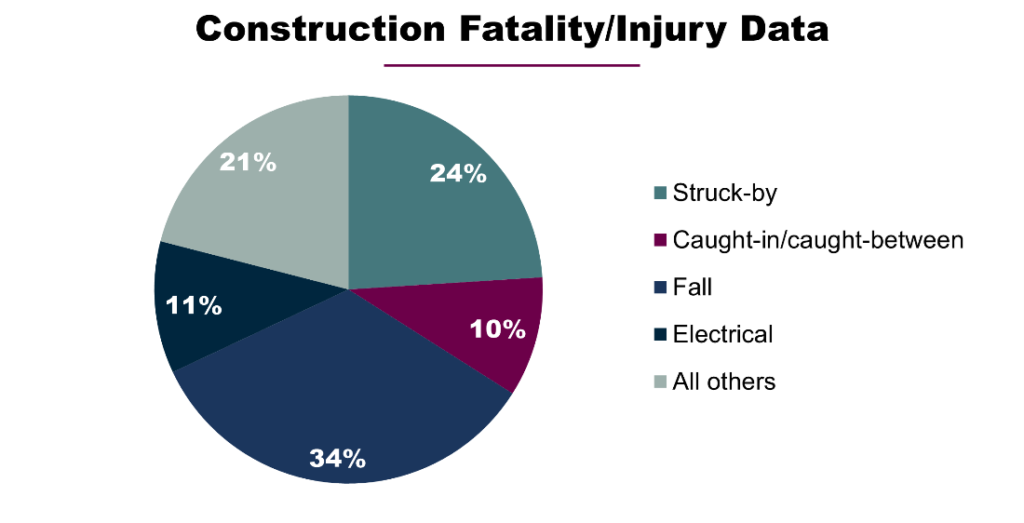Insurance can be a significant expense in the construction industry, making it essential for companies to understand the major risks impacting job sites and what they can do to control them. With that sentiment in mind, we invited Kyle Cochran — Senior Vice President at Vista Safety Consulting — to join our weekly Risk Control Webinar series and talk about two of the most significant safety hazards for construction sites:
Here’s a brief overview of Cochran's presentation to help your company better understand these hazards.
Struck-by hazards and caught-in/caught-between hazards are relatively similar, but with one major distinction. According to OSHA, “struck-by injuries are produced by forcible contact or impact between the injured person and an object or piece of equipment,” while a caught-in/caught-between injury “is created more as a result of crushing injuries between objects.” Basically, if the object that strikes the person is the singular cause of the injury, it’s a struck-by hazard.
According to Cochran, these hazard types combine to account for more than a third of construction-related fatalities.

Let’s look at each hazard in more detail.
While there are many ways an object can strike a person, Cochran examined a couple of the most common ways struck-by hazards lead to injuries or fatalities on the job site.
Overhead hazards are inevitable on many job sites. If a project requires work on more than one story of a structure (or anywhere above six feet or so really), workers and bystanders are subject to the risk of falling objects. The fact that overhead hazards are so prevalent is part of what makes falling objects so dangerous.
“A lot of the hazard is people becoming complacent since they’re used to seeing objects overhead every day,” said Cochran. “Sure, the odds of something falling are very low. But the odds of surviving if something does fall are also very low.”
Fortunately, with the proper safety precautions and mindset, your company can minimize these risks by taking steps like:
The construction industry often involves large vehicles that can cause severe injury and death when they strike a human. While any vehicle presents a risk on the job site, it's typically tougher to stop or maneuver larger machines, which makes it even more essential to take precautions that avoid incidents. To help in this endeavor, Cochran offered tips like:
According to OSHA, caught-in/caught-between hazards are “injuries resulting from a person being squeezed, caught, crushed, pinched, or compressed between two or more objects, or between parts of an object. This includes individuals who get caught or crushed in operating equipment, between other mashing objects, between a moving and stationary object, or between two or more moving objects.”
Here are some of major caught-in/caught-between hazards that Cochran covered.
According to data from Cochran's presentation, excavation cave-ins account for 43 worker deaths per year, on average. Nearly 80 percent of cave-ins involving a trench happened in relatively shallow spaces (5 to 15 feet deep). The direct cause of cave-in deaths and injuries include suffocation, crushing, loss of circulation, and fall objects.
When it comes to heavy equipment-related safety hazards, crushing is the preeminent cause of injury and death. Crushing could include being compressed between moving objects like a semi-trailer and a wall or caught between a truck frame and hydraulic bed.
Another significant hazard with heavy equipment is the risk of a vehicle rollover. To combat this risk, Cochran offered a tried-and-true precaution — wearing a seat belt. On top of that, he stressed the importance of making sure workers only ride in appropriate seats and avoid riding in buckets, on fenders, or steps.
The tools and machines that allow your employees to do their jobs may also represent significant caught-in/caught-between hazards. An example of this hazard would be a worker getting pulled into or caught in a piece of machinery.
To help your company protect workers, here are a few common causes of machine incidents to avoid:
To learn more about protecting your company against job site hazards, check out Vista Safety Consulting’s website.
This presentation was part of CRI’s Risk Control Webinar Series — weekly installments of webinars to educate the group captive members we work with on topics like workplace safety, organizational leadership, and company performance. The thoughts and opinions expressed in these webinars are those of the presenters and do not necessarily reflect CRI’s positions on any of the above topics.